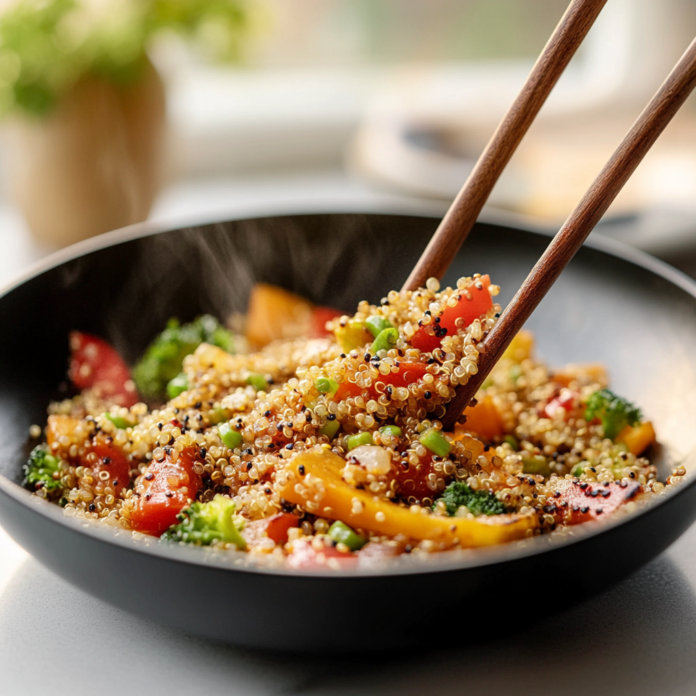Introduction and Quick Summary
Quinoa and Vegetable Stir-Fry with Soy Sauce is a delightful dish that combines nutrition and flavor in one vibrant bowl. This recipe is not just quick to prepare but also versatile enough to accommodate various vegetables you may have on hand. Whether you’re a busy professional seeking a wholesome dinner or a parent looking for a nutritious meal for the family, this stir-fry ticks all the boxes. The nutty flavor of quinoa pairs perfectly with fresh vegetables like bell peppers, broccoli, and carrots, all enhanced by a savory soy sauce. With this recipe, you can easily whip up a satisfying meal in under 30 minutes.
This stir-fry is not only visually appealing but also rich in protein and fiber due to quinoa’s unique profile. Additionally, the use of soy sauce brings an umami punch that elevates the dish to new heights. You can customize the vegetables based on your preference or what’s available in your fridge. This recipe is gluten-free if you opt for tamari instead of regular soy sauce. Enjoy this delicious Quinoa and Vegetable Stir-Fry with Soy Sauce as a main dish or as a side to complement your protein choices.
Main Ingredients
Quinoa
Quinoa serves as the foundation of this dish. For four servings, you’ll need one cup of uncooked quinoa. This ancient grain is gluten-free and packed with protein, making it an excellent choice for vegetarians and those looking to boost their nutrient intake. To prepare it, rinse the quinoa under cold water to remove its natural coating called saponin, which can impart a bitter taste. Cook it in two cups of water or vegetable broth until fluffy—about 15 minutes.
Bell Peppers
You’ll need one red bell pepper and one yellow bell pepper for color and sweetness. Slice them thinly so they cook evenly in the stir-fry. Bell peppers are rich in vitamins A and C along with antioxidants that support immune health. Their crunch adds texture to the dish while their vibrant colors make it visually appealing.
Broccoli
Include one cup of broccoli florets for added nutrition. Broccoli is known for its high vitamin K content as well as being a good source of vitamin C and fiber. When adding broccoli to your stir-fry, cut the florets into small pieces to ensure they cook quickly but remain slightly crisp—a perfect complement to the other ingredients.
Carrots
Carrots are another key ingredient; you will need two medium-sized carrots sliced thinly or julienned. They provide sweetness along with beta-carotene, which converts into vitamin A in the body. Their vibrant orange color adds visual appeal while providing essential nutrients that promote eye health.
Soy Sauce
For seasoning, use three tablespoons of soy sauce or tamari if you prefer gluten-free options. Soy sauce enhances flavor through its salty umami profile while adding depth to your stir-fried vegetables. It’s crucial not to add too much at once; start slow—taste as you go!
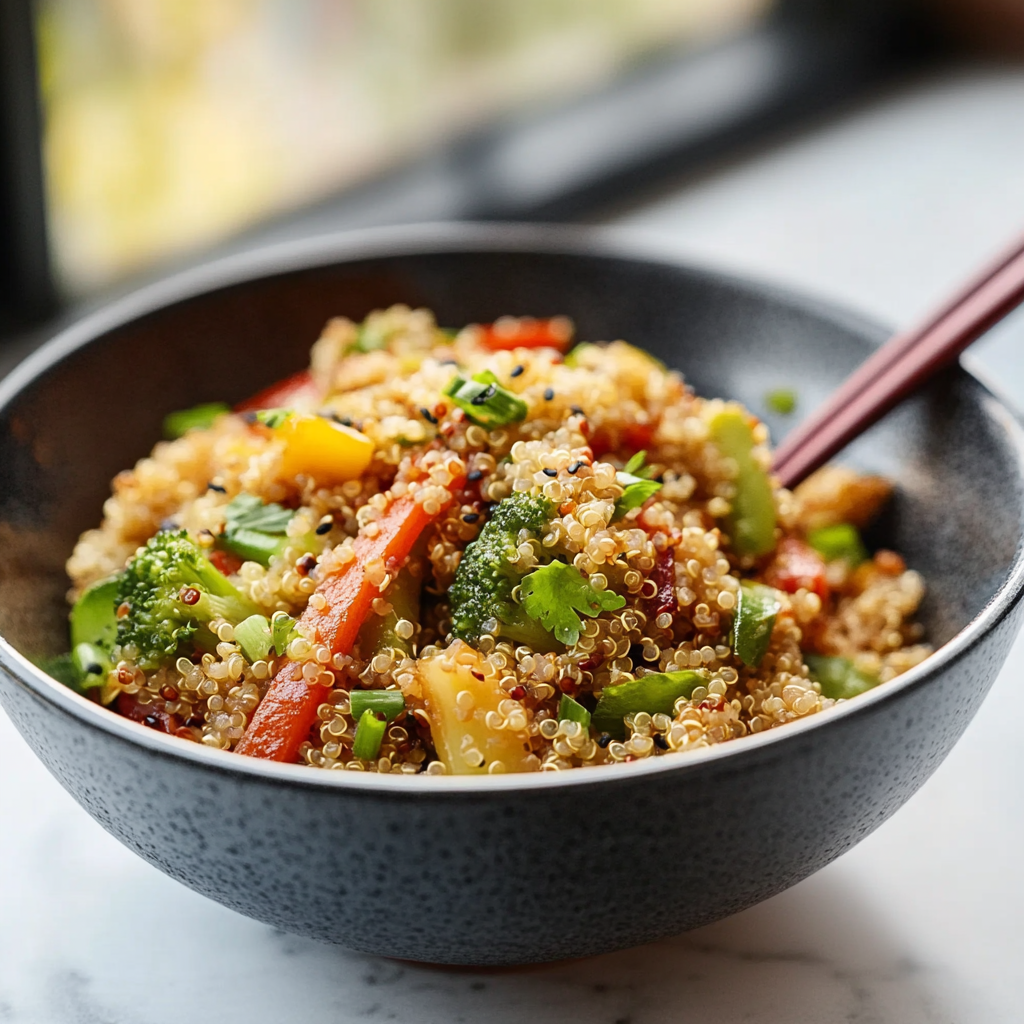
How to Prepare Quinoa and Vegetable Stir-Fry with Soy Sauce
Step 1: Cooking the Quinoa
Start by rinsing one cup of uncooked quinoa under cold water using a fine-mesh strainer; this removes any bitterness from saponins found on its surface. In a medium-sized saucepan over high heat, combine the rinsed quinoa with two cups of water or vegetable broth—using broth adds extra flavor! Bring it to a rolling boil before reducing the heat to low; cover tightly with a lid allowing it to simmer for about 15 minutes until all liquid has absorbed.
Once cooked, remove from heat but keep covered for an additional five minutes—this resting time allows steam to fluff up the grains further! Afterward, remove the lid; fluff your quinoa gently using a fork before setting aside while preparing vegetables.
Step 2: Preparing Vegetables
While your quinoa cooks away happily on its own stovetop journey let’s focus on our colorful assortment of veggies! Begin by washing one red bell pepper and one yellow bell pepper thoroughly; then slice them thinly after removing seeds & stems.
Next comes our broccoli—take one head (around one cup) & separate into small florets ensuring even cooking! For carrots—wash two medium-sized ones then peel them off before slicing thinly into rounds or julienning if preferred!
Now that we’ve got everything prepped feel free to toss these beautiful ingredients into a large mixing bowl while waiting for that fragrant aroma from our next step!
Step 3: Stir-Frying Vegetables
In a large skillet or wok over medium-high heat add two tablespoons of olive oil (or sesame oil if desired). Once hot enough (you’ll know when it shimmers), add sliced bell peppers first since they take longer than other veggies! Sauté them for approximately three minutes until slightly tender yet still crunchy!
Next up are our carrot slices followed closely by broccoli florets; continue stirring frequently allowing each piece enough contact time with heated surfaces until vibrant colors shine through (roughly five more minutes)!
Finally drizzle three tablespoons worth of soy sauce evenly across cooked vegetables tossing gently so flavors meld perfectly together! Don’t forget—to taste test at this stage—it’s where magic happens!
Step 4: Combining Everything Together
Now that both components are ready let’s unite them into glorious harmony! Add cooked quinoa directly onto sautéed veggie mixture ensuring everything combines well without clumping together—use wooden spatula gently folding ingredients together like embracing old friends!
Allow this medley an additional minute on heat merely warming through—not cooking further—as we want textures intact while flavors mingle beautifully! Once combined serve immediately either plated individually or family-style right from skillet onto dining table!
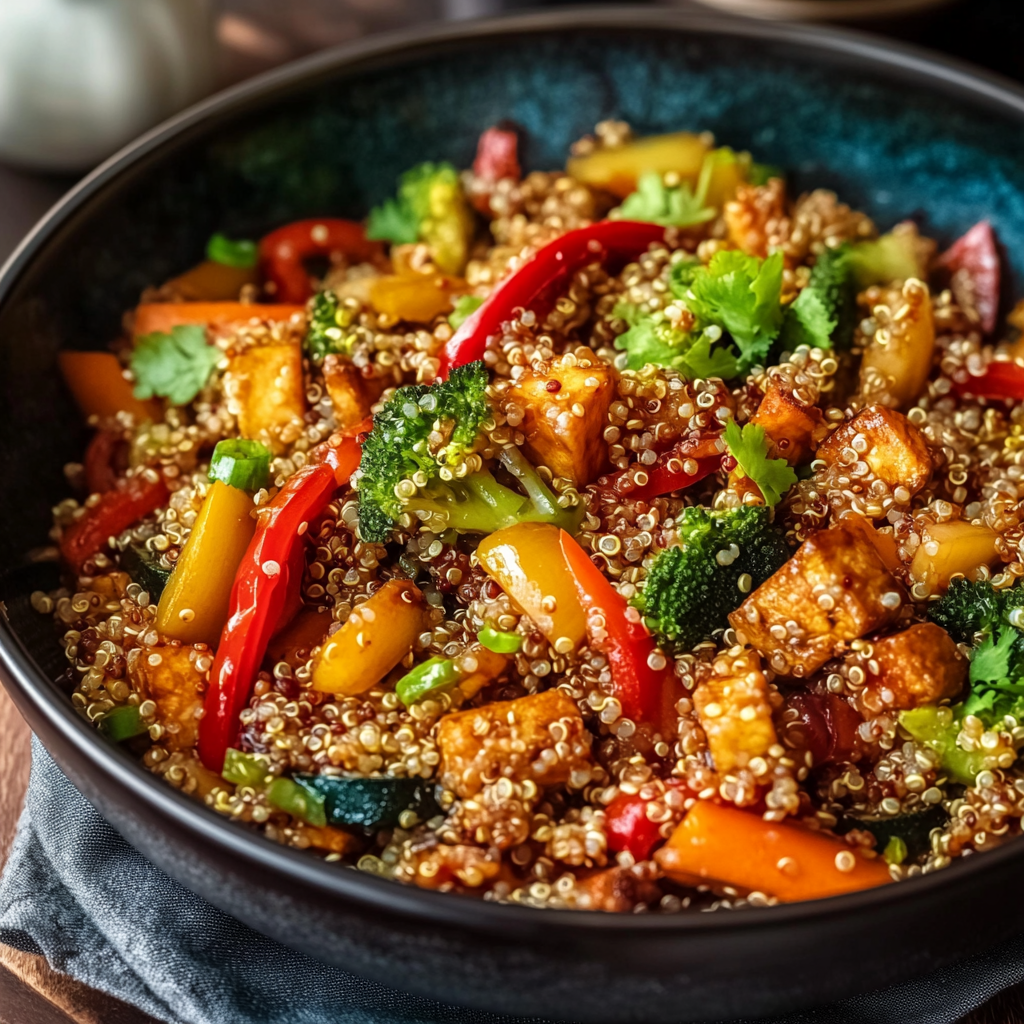
Serving and Storing Tips
Serving Suggestions
When serving your Quinoa and Vegetable Stir-Fry with Soy Sauce consider garnishing each plate with chopped green onions or sesame seeds sprinkled atop—a delightful final touch enhancing both aesthetics & taste experience! This dish stands alone wonderfully as its own meal yet pairs exceptionally well alongside grilled chicken or tofu if desired!
For those looking for extra kick add hot chili flakes over top before diving into flavorful bites! Serve warm straight from stovetop ensuring everyone indulges while fresh—nothing beats enjoying dishes prepared right then & there!
Should leftovers remain after mealtime do not fret—they’re just as delightful stored away awaiting another encounter later down line too!
Storage Guidelines
To store any leftover Quinoa and Vegetable Stir-Fry simply transfer cooled portions into airtight containers once at room temperature—this helps prevent moisture buildup leading towards spoilage faster than necessary! Refrigerate accordingly consuming within three days maximum should ensure freshness remains intact upon reheating later on.
Reheating can be done either via microwave-safe dishes covered lightly utilizing short bursts (1-minute intervals) until warmed through—or alternatively utilize stovetop method within skillet drizzling little bit more olive oil keeping flavors alive whilst preventing dryness occurring during process too!
By following these simple storage tips along enjoying every last bite together—you’ll find yourself fully satisfied knowing all aspects considered throughout entire culinary journey created here today!
Mistakes to avoid
When preparing a Quinoa and Vegetable Stir-Fry with Soy Sauce, there are several common mistakes that can affect the flavor and texture of your dish. Avoiding these pitfalls will help you create a meal that is not only delicious but also visually appealing.
One major mistake is overcooking the quinoa. Quinoa should be fluffy, not mushy. To achieve the perfect texture, rinse the quinoa thoroughly before cooking to remove its natural coating called saponin. Cook it in a 2: 1 water-to-quinoa ratio and let it simmer gently. Once cooked, allow it to rest for a few minutes before fluffing with a fork.
Another common error is neglecting the vegetables’ preparation. Different vegetables have varying cooking times, and adding them all at once can lead to unevenly cooked stir-fry. To ensure each vegetable retains its crunch and color, cut them into uniform sizes and add them to the pan in stages based on their required cooking times. For instance, denser vegetables like carrots should go in first, while leafy greens can be added later.
Using too much soy sauce can overpower your dish, making it overly salty. It’s best to start with a small amount and taste as you go. You can always add more soy sauce or incorporate other seasonings like ginger or garlic for enhanced flavor without excessive saltiness.
Lastly, failing to let your pan heat up adequately before adding ingredients can lead to steaming rather than stir-frying. Ensure your pan is hot enough so that when you add oil, it shimmers immediately. This high heat will give your stir-fry that delightful sear and prevent ingredients from sticking.
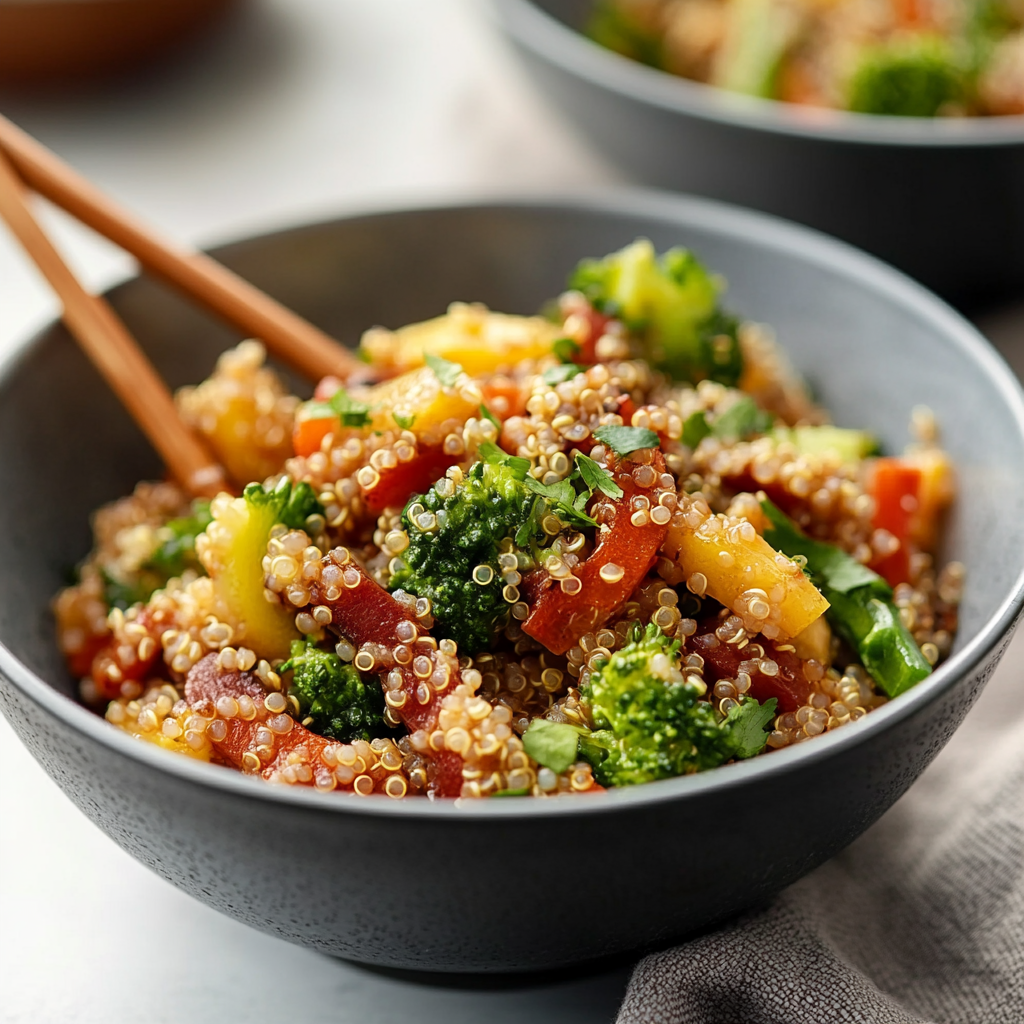
Tips and tricks
To elevate your Quinoa and Vegetable Stir-Fry with Soy Sauce, consider these essential tips and tricks that enhance both flavor and nutrition.
First, incorporating various colors of vegetables not only makes your dish more visually appealing but also boosts its nutritional profile. Aim for a rainbow of veggies such as bell peppers, broccoli, snap peas, and carrots. Each color represents different vitamins and antioxidants that are beneficial for health.
Secondly, experiment with different types of soy sauce for varied flavors. Regular soy sauce has a salty taste while tamari offers a gluten-free alternative with a richer profile. Consider using low-sodium soy sauce if you want to control salt intake without sacrificing flavor.
Another tip is to include aromatics like garlic and ginger at the beginning of the cooking process. Sautéing minced garlic or ginger in oil before adding vegetables releases their essential oils and enhances the overall taste of the dish significantly.
Adding protein is another way to make your stir-fry more filling. Consider incorporating tofu or edamame for plant-based protein sources or chicken or shrimp for an animal protein option. Marinating these proteins in soy sauce prior to cooking can infuse additional flavor into your stir-fry.
Finally, don’t forget about garnishes! A sprinkle of sesame seeds or chopped green onions adds an appealing touch while providing extra crunch and flavor contrast. These small details can transform an everyday meal into something special.
Suggestions for Quinoa and Vegetable Stir-Fry with Soy Sauce
If you’re looking to enhance your Quinoa and Vegetable Stir-Fry with Soy Sauce further, here are some suggestions that can take your dish from good to great.
Consider adding a splash of citrus juice like lime or lemon just before serving for a bright finish that complements the savory elements beautifully. The acidity balances out rich flavors from soy sauce while enhancing freshness in every bite.
Experimenting with different grains besides quinoa may also be rewarding if you’re feeling adventurous. Grains like brown rice or farro provide unique textures and flavors while still being nutritious alternatives.
You might also think about incorporating nuts or seeds into your stir-fry for added crunch and healthy fats. Almonds or cashews work wonderfully when toasted lightly beforehand; their nutty flavor enriches the overall dish immensely.
For those who enjoy spice, consider adding chili flakes or fresh chilies during cooking for an extra kick! Adjust heat levels according to personal preference; this simple addition can elevate the entire experience.
Lastly, consider meal prepping by making larger batches of quinoa ahead of time; this not only saves time but ensures you have healthy grains ready whenever cravings strike!
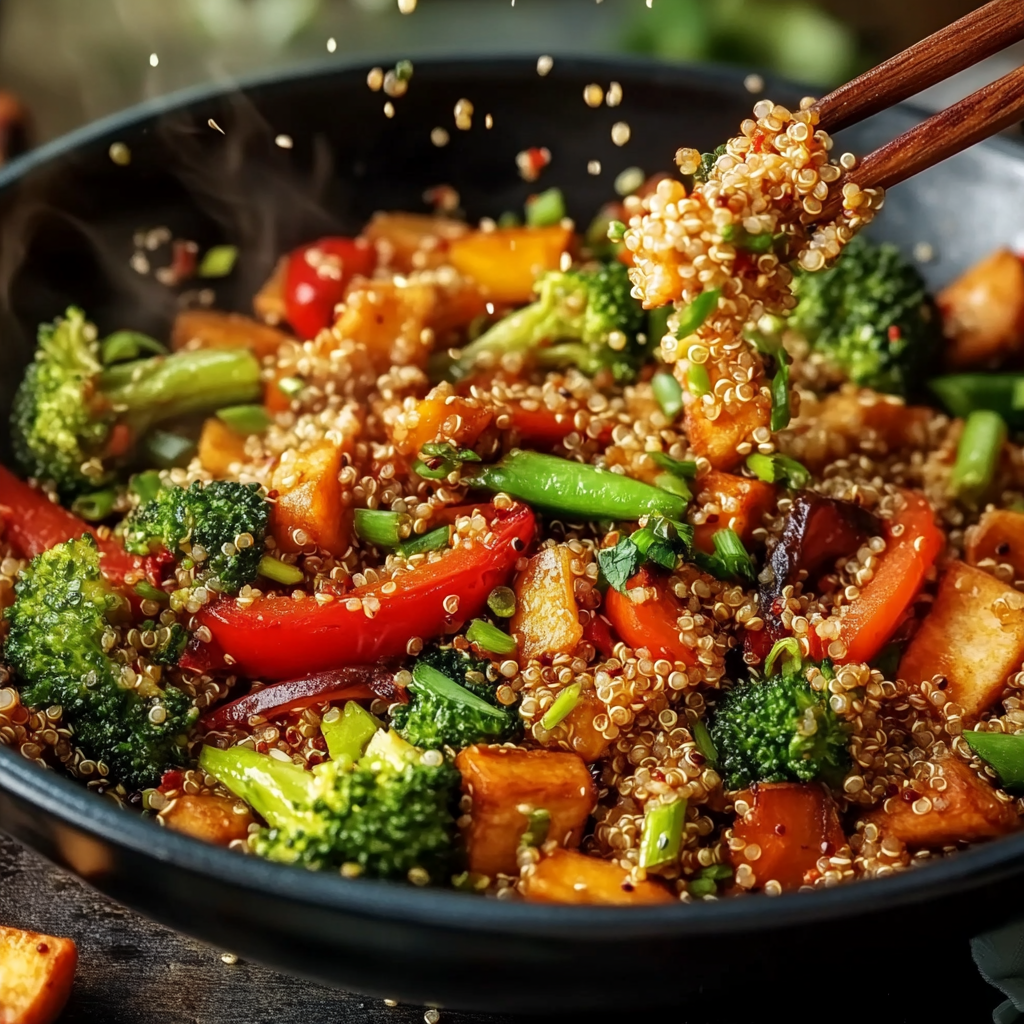
FAQs
What vegetables work best in Quinoa and Vegetable Stir-Fry with Soy Sauce?
When making Quinoa and Vegetable Stir-Fry with Soy Sauce, choose vibrant vegetables such as bell peppers, broccoli, snap peas, carrots, zucchini, and bok choy. These options provide both color and crunch while offering diverse nutrients essential for health. Cut the veggies into uniform sizes so they cook evenly—a key factor in achieving that perfect stir-fried texture!
Can I use other sauces instead of soy sauce?
Absolutely! While soy sauce gives an authentic flavor to your stir-fry, there are numerous alternatives available. You might try teriyaki sauce for sweetness or coconut aminos as a gluten-free option with less sodium content than traditional soy sauces. Each option offers unique benefits without compromising on taste!
How long does cooked quinoa last in the fridge?
Cooked quinoa generally lasts up to five days when stored properly in an airtight container within the refrigerator. Make sure it cools completely before sealing it away to maintain freshness longer! If you notice any off smells or textures after this period—discard it immediately!
Is this recipe suitable for meal prep?
Yes! Quinoa makes an excellent base for meal prep due its versatility; prepare larger batches at once then store portions separately alongside prepped veggies ready-to-stir-fry throughout your week! This method provides healthy lunches/dinners quickly without sacrificing quality—perfect for busy lifestyles!
Can I freeze leftover stir-fry?
While it’s possible to freeze leftover Quinoa and Vegetable Stir-Fry with Soy Sauce, keep in mind certain textures may change upon thawing—particularly fresh vegetables which tend towards sogginess after freezing processes! To avoid this issue: cook just enough servings necessary rather than freezing large quantities unnecessarily!
What protein options pair well with this dish?
Incorporating protein enhances both satisfaction levels within meals alongside nutritional value overall! Tofu serves as an excellent vegetarian option packed full of nutrients—while chicken breast/shrimp offer lean animal proteins ideal when marinated beforehand imparting additional flavors throughout dishes effortlessly!
Conclusion
In summary, crafting a delightful Quinoa and Vegetable Stir-Fry with Soy Sauce involves avoiding common mistakes such as overcooking ingredients or using excessive soy sauce which could compromise flavor profiles drastically! By incorporating diverse colorful vegetables along with strategic cooking techniques—like sautéing aromatics first—you’ll create meals bursting with vibrancy!
Additionally utilizing tips like experimenting with different sauces & garnishes ensures creativity remains alive within culinary adventures ahead! Remember always choose high-quality ingredients tailored according individual tastes/preferences—the result shall be nourishing yet satisfying creations everyone will enjoy without question!
Finally always keep meal prep strategies handy allowing flexibility throughout busy weeks ensuring healthful choices remain accessible daily regardless schedules may throw our way—making life easier one delicious bite at time!
